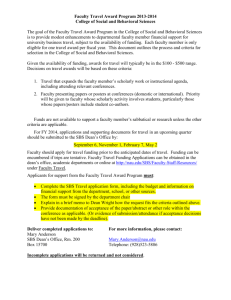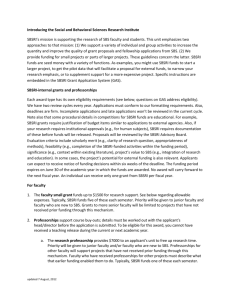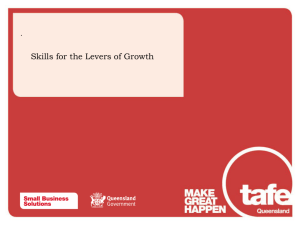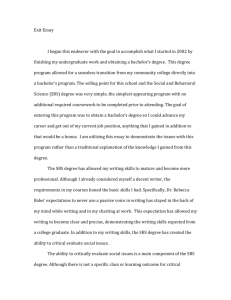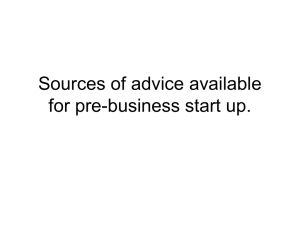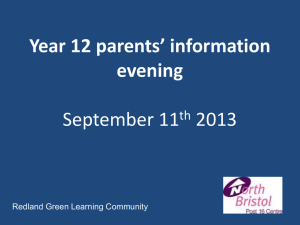SBS National Ant-Racism Strategy Submission
advertisement
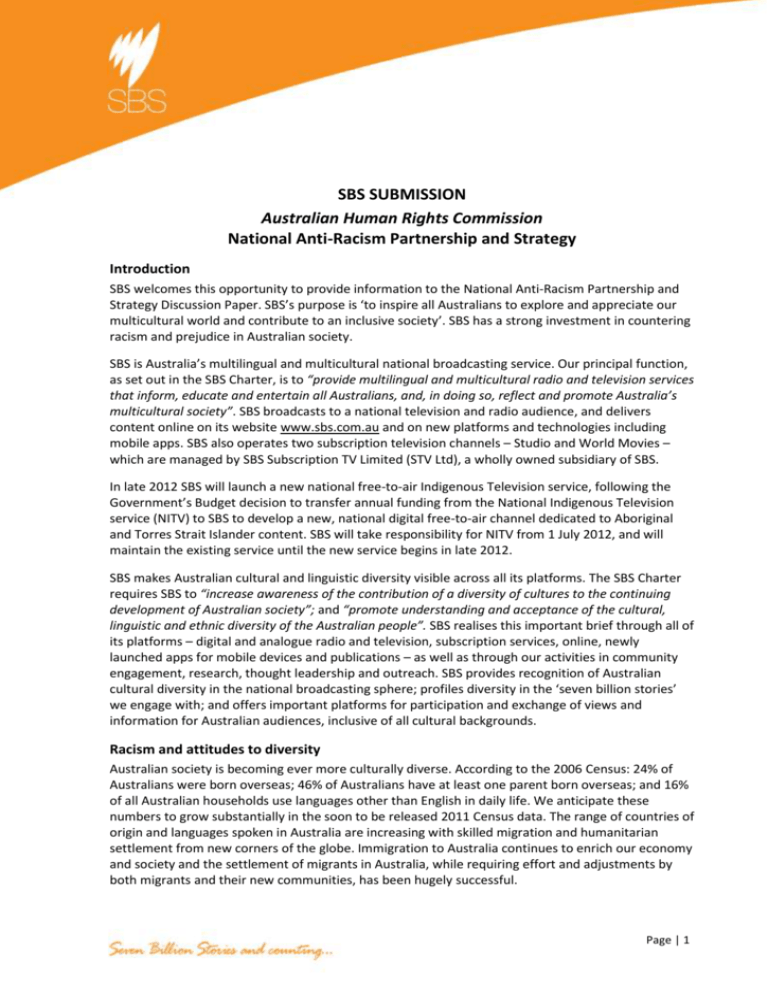
SBS SUBMISSION Australian Human Rights Commission National Anti-Racism Partnership and Strategy Introduction SBS welcomes this opportunity to provide information to the National Anti-Racism Partnership and Strategy Discussion Paper. SBS’s purpose is ‘to inspire all Australians to explore and appreciate our multicultural world and contribute to an inclusive society’. SBS has a strong investment in countering racism and prejudice in Australian society. SBS is Australia’s multilingual and multicultural national broadcasting service. Our principal function, as set out in the SBS Charter, is to “provide multilingual and multicultural radio and television services that inform, educate and entertain all Australians, and, in doing so, reflect and promote Australia’s multicultural society”. SBS broadcasts to a national television and radio audience, and delivers content online on its website www.sbs.com.au and on new platforms and technologies including mobile apps. SBS also operates two subscription television channels – Studio and World Movies – which are managed by SBS Subscription TV Limited (STV Ltd), a wholly owned subsidiary of SBS. In late 2012 SBS will launch a new national free-to-air Indigenous Television service, following the Government’s Budget decision to transfer annual funding from the National Indigenous Television service (NITV) to SBS to develop a new, national digital free-to-air channel dedicated to Aboriginal and Torres Strait Islander content. SBS will take responsibility for NITV from 1 July 2012, and will maintain the existing service until the new service begins in late 2012. SBS makes Australian cultural and linguistic diversity visible across all its platforms. The SBS Charter requires SBS to “increase awareness of the contribution of a diversity of cultures to the continuing development of Australian society”; and “promote understanding and acceptance of the cultural, linguistic and ethnic diversity of the Australian people”. SBS realises this important brief through all of its platforms – digital and analogue radio and television, subscription services, online, newly launched apps for mobile devices and publications – as well as through our activities in community engagement, research, thought leadership and outreach. SBS provides recognition of Australian cultural diversity in the national broadcasting sphere; profiles diversity in the ‘seven billion stories’ we engage with; and offers important platforms for participation and exchange of views and information for Australian audiences, inclusive of all cultural backgrounds. Racism and attitudes to diversity Australian society is becoming ever more culturally diverse. According to the 2006 Census: 24% of Australians were born overseas; 46% of Australians have at least one parent born overseas; and 16% of all Australian households use languages other than English in daily life. We anticipate these numbers to grow substantially in the soon to be released 2011 Census data. The range of countries of origin and languages spoken in Australia are increasing with skilled migration and humanitarian settlement from new corners of the globe. Immigration to Australia continues to enrich our economy and society and the settlement of migrants in Australia, while requiring effort and adjustments by both migrants and their new communities, has been hugely successful. Page | 1 Recent Ipsos McKay research1 commissioned by SBS in 2011 found that 60% of first generation migrants felt a strong sense of belonging to Australia and, significantly, by the second generation this had risen to 80%, in line with the national average. This finding is evidence of the success of Australian multiculturalism. However, the research also found that this success is not universally appreciated by Australians. The Ipsos McKay study found that 22% of Australians remain resistant to immigration (a segment labelled ‘Under No Circumstances’ in the study); around 23% saw its economic benefit to Australia but remained unsure of its impact on society (‘Fear of the Foreign’); 27% appreciated the benefits of diversity but wanted immigration strictly controlled (‘On our Terms’); and 28% felt immigration could be increased (‘Room for More’). The Ipsos McKay Report: SBS Immigration Nation (2011) The research found that in at least three of the four segments anxieties and concerns about the impact of immigration on our society now and into the future were significant and numerous. In relation to current or increased levels of immigration, there was reservation (‘On our Terms’), fear (in ‘Fear of the Foreign’) and outright opposition (‘Under no Circumstances’). The qualitative research shows that the drivers of opposition are relatively predictable and reflect concerns about cultural identity, social cohesion, economic prosperity and (more recently) environmental sustainability. Racism continues to be a significant problem in Australia. 23% of culturally and linguistically diverse (CALD) respondents in the Ipsos McKay study reported that they had experienced racial discrimination in the last twelve months. The report states: Both the review and particularly the qualitative research component uncovered stories of subtle and extreme examples of racism. In terms of perception about racism in Australian society it is a situation of ‘two steps forward, one step back’. The qualitative research shows that migrants from European and some Asian backgrounds feel that racism directed towards their ethnic groups had diminished over time. However there was also a perception that general levels of racial intolerance have increased in recent times. The notion that racism is worse now than it has been previously was mirrored in the quantitative phase (with no significant difference in attitude between CALD and non-CALD respondents). (p.153) 1 Ipsos-Eureka Social Research Institute (2011). The Ipsos McKay Report: SBS Immigration Nation. (www.sbs.com.au/ aboutus/corporate/index/id/40/h/Policies-Publications) Page | 2 One of the important findings was that reservations about diversity in Australia tended to be focused on new migrant groups and fears about earlier waves of migration had not be borne out in the Australian experience: As reported in The Ipsos Mackay Report review recent arrivals caused greater concern than migrants with a long history in Australia. Forty years ago, Greeks, Italians and other post-war migrants were the primary target of racism; today the focus has shifted to more recently-arrived ethnic groups. (p. 127) There is an important role for our media, and political and community leaders, to emphasise the benefits of diversity and remind us of the successes of previous waves of migration. The role of media Media play a central role in the acceptance and appreciation, or otherwise, of cultural diversity. In contemporary societies, media are central to developing our understandings of the world and each other. The 2006 Reporting Diversity study found that the majority of representations of cultural difference in Australian media conformed to “bad, sad, mad or other” stereotypes – with the noted exception of SBS.2 In our own consultations and research with CALD communities, SBS continually hears of frustrations with the failure of the ‘mainstream media’ to reflect diversity outside ‘moral panics’ and continual inaccurate or exaggerated stories of gangs, dysfunction, crime, ‘home-grown terror’ or welfare dependency. The Ipsos McKay study found: …all phases of the research showed reasonably low levels of trust in the information gleaned by media about immigration, asylum seekers and migrants in general (with some differences between CALD and non-CALD respondents). Respondents in the qualitative phase in particular criticised media bias and the lack of ‘different faces’ on television screens. (p. 4) These perceptions are also borne out amongst Indigenous Australians, with the majority of the Indigenous Australians interviewed for SBS’s 2001 Living Diversity report expressing dissatisfaction with the ways their communities were represented in Australian media. In 2010, Reconciliation Australia’s “Barometer” identified that only 9% of Aboriginal and Torres Strait Islander respondents and 16% of non-Indigenous respondents agree that the media provides a balanced view of Indigenous Australia.3 SBS, because of its unique model and Charter provides an important counterforce to these tendencies. Media which effectively engages with diversity provide opportunities for participation and engagement across cultural difference for audiences of all backgrounds. It does this by: providing recognition of cultural diversity; offering opportunities for engagement and empathy; creating platforms for participation and originating important national conversations about multiculturalism which contribute to social cohesion. The Discussion Paper requests examples of strategies, resources and experiences effective in countering racism. The following section will briefly describe some the work of SBS in each of these areas, with evidence of its impact in our complex multicultural society. 2 3 http://www.reportingdiversity.org.au/ Reconciliation Australia (2010). Australian Reconciliation Barometer, p.40. Page | 3 SBS Radio is the world’s most multilingual media service, with more than 60 language programs on analogue and digital platforms. This formal recognition of the linguistic diversity of the Australian population is crucial to including many Australians, for whom English is not their first or preferred language, in the Australian broadcasting sphere. In a media environment in which transnational and homeland media are increasingly accessible via online and satellite platforms, SBS Radio provides a crucial link between language communities and Australian perspectives on news and information and crucial building blocks to local civic and political participation. The 2008 ABS General Social Survey found that language was still a significant stumbling block to participation in Australia and continued to be linked to social disadvantage. SBS’s multilingual services have extended onto new platforms in recent years. Chinese Virtual Community Centre: a pilot social networking and news website launched in February 2011, featuring text, audio and video content in Mandarin and Chinese. It aggregates SBS’s current Mandarin and Cantonese content with new services and user-generated content capabilities. It also hosts a pilot news service which is also broadcast on SBS TWO, Mandarin News Australia, a locally-produced professional news service in Mandarin with an Australian perspective on current events. The intention is to grow the SBS Australian Chinese audience, and provide deeper engagement with a richer, integrated and interactive content experience. Your-Language App: a free app launched in 2011 allowing users to livestream and replay radio programs in more than 60 languages. The app can be accessed on the iPhone, iPad and iPod Touch, and on Android platforms and features reminders, schedule information and interactive features such as voting and audience feedback via text, email or phone. Digital radio music channels: SBS PopAsia and SBS Chill are aimed at providing a multicultural music service accessible to all Australians. The objective is to get Australians to engage with music and culture that is outside their predominant culture, helping them appreciate some of the benefits of multicultural Australia. SBS Television represents a range of cultures and perspectives on screen through news, sport and locally commissioned and internationally acquired content. Research tells us that storytelling can humanise, normalise and de-mystify the experiences of people from cultural groups other than one’s own. SBS ensures that the many stories of CALD and Indigenous Australians are recognised as key parts of the Australian story. The ‘seven billion stories’ reflected in SBS content provide important points of reference for understanding cultural difference. SBS has long promoted culturally diverse news presenters, talent and stories which de-marginalise the representation and perspectives of CALD Australians. In 2008 SBS commissioned a study into audience and industry engagement with two SBS dramas East West 101 (centring on the work of a multicultural police squad in Sydney’s West, headed by a Muslim detective) and The Circuit (following a circuit court in remote Indigenous communities in the Page | 4 Kimberley region in Western Australia).4 The research found that: “By imbuing TV content with the same cultural diversity we see when we walk in our own neighbourhoods, our focus group participants told us this definitely had the potential to become a force for social change”; and noted that, amongst the study participants: “There was a widespread belief that exposure to and identification with characters from other cultural backgrounds impacts on interpersonal relationships in everyday life”. The study also revealed that engagement with characters from cultures other than their own elicited empathy amongst audiences for the situations of others – a crucial step to countering prejudice and racism. A further study, commissioned by SBS in 2011, found that SBS documentaries and factual series fill an important knowledge gap in the understandings and awareness of diversity amongst Australian viewers.5 SBS TV content draws on a range of genres and approaches to challenge expectations and prejudices about different communities in Australia, some examples include the following. Untold histories: SBS’s recent landmark documentary series have filled significant knowledge gaps in Australian audiences’ understandings of the histories Indigenous and migrant Australians and their role in Australian culture. First Australians, on the history of first contact between Indigenous and white Australians told from an Indigenous perspective. Immigration Nation: the Secret History of Us which told the stories of Australia’s successful immigration program emerging from our racist past under the White Australia Policy. Once Upon a Time in Cabramatta told the story of how the Vietnamese community found their place in modern Australia, documenting the extraordinary transformation of this small suburb in Sydney – from the influx of Vietnamese refugees following the Vietnam War, to the crime and violence, the fear and racism, a heroin epidemic and the first political assassination in Australia’s history, and the fight back as this community found its voice. Challenging content: Go Back To Where You Came From explored the attitudes of Australians to asylum seekers in the context of a heated debate on the issue. Program participants were taken on an immersive reverse journey to the countries of origin of families of asylum seekers they meet in Australia – the series sparked a storm of powerful empathetic responses from viewers on a range of platforms, particularly social media. Satire: comedy and satire programs such as Pizza and Housos expose stereotypes by parodying them. SBS sees satire as an important element of expression and a powerful vehicle of exposing and countering prejudice and racism. Factual entertainment: the upcoming series Bollywood Star involves a talent search for an Australian Bollywood performer, filmed half in Australia and half in India using the vehicle of a reality TV series to explore India and its hugely successful film industry. 4 Entertainment Insights (2008). Audience and industry engagement: An exploration of the SBS case study programs East West 101 and The Circuit. Unpublished. 5 Entertainment Insights (November 2011). Audience engagement with SBS documentary content. (www.sbs.com.au/ aboutus/corporate/index/id/40/h/Policies-Publications) Page | 5 SBS Online extends the ways audiences can engage and interact with SBS content and provides opportunities for user-generated content, chat, comment and sharing of content, and ideas that are inclusive of Australians from a whole range of backgrounds. SBS aims to create a safe space for engagement with others and creates unique opportunities for groups and individuals to learn from one another. A recent study of audience uses of SBS online for chat and comment following the current affairs program Insight found that: • • • • online comments were ‘freer’ than televised (editorially managed) forum content and went beyond ‘publicly endorsed’ positions; the forums were used by many as a resource for advice, information or opinion, including about other cultural groups; divergent views ‘came together’: examples of exchange of opposing views, also evidence of exchange of information and engagement with others’ opinions; individuals’ own opinions tended to address a broad imagined audience – views may have been polarised but were not ‘ghettoised’.6 SBS Outreach SBS Outreach creates partnerships between SBS and key organisations, particularly in the CALD sector, to extend the public value of SBS content and maximise its benefit. Recent examples include: SBS and ICE (Information and Cultural Exchange) partnered in an innovative community storytelling project to capture the voice of Cabramatta and generate and facilitate discussion of the issues raised in the documentary Once Upon a Time in Cabramatta (January 2012); a World Refugee Week teachers pack providing information, case studies and resources and challenging myths about refugees distributed to all secondary schools in Australia. This resource was produced in partnership with the Refugee Council of Australia and Amnesty International to coincide with the broadcast of Go Back to Where You Came From (2011); a resource on intergenerational issues for CALD families distributed through SBS stakeholder networks and Relationships Australia offices nation-wide, produced in collaboration with cultural perspectives, Relationships Australia and FECCA, in conjunction with the broadcast of The Family (2011). SBS Thought Leadership SBS has an objective to be the ‘catalyst for the nation’s conversations about multiculturalism and social cohesion’. As part of this ambition, SBS conducts research and hosts discussions about key issues around Australian diversity. SBS’s flagship ‘thought leadership’ initiative, called SBS CQ: cultural intelligence, is a series of debates that bring together media practitioners, community representatives, commentators, academics and critics to discuss issues of media and diversity. SBS CQ is hosted at sbs.com.au/cq and provides an ongoing resource to communities, journalists, media students, researchers and opinion leaders on cultural diversity and media practice. 6 McClean, G. (2011). Multicultural Sociability, Imperfect Forums and Online Participation. International Journal of Communication, 5, 1649 –1668. Page | 6 SBS Community Engagement Community engagement centres on two-way conversations that SBS maintains with the CALD sector in the form of partnerships, relationships and consultations. These conversations and relationships assist SBS to deliver on its Charter obligations to contribute to meeting the communications needs of multicultural Australia and reflect the ways our diverse society is changing. They also help us maximise the public benefit of our services and ensure that SBS is valued amongst the communities that it was established to service. Activities outlined under SBS’s current Community Engagement Plan include: Partnerships and activities around theme weeks, festivals and community events. Media mentorships for students of CALD and refugee backgrounds to improve career opportunities for culturally diverse emerging media practitioners. CALD sector communications forum to improve practices around CALD communications amongst Government departments and agencies. Online Community Exchange – an ongoing engagement with CALD sector stakeholders around the direction and priorities of SBS. SBS’s Indigenous initiatives SBS supports Aboriginal and Torres Strait Islander identity and culture by providing television, radio and online services covering Indigenous news and current affairs, documentary, drama and special event programming. From 1 July 2012, SBS will also take responsibility for NITV, and will launch a new national free-to-air Indigenous Television service in late 2012. Through its weekly current affairs program Living Black, and Living Black Radio, SBS informs an Australia-wide audience about contemporary Indigenous issues. SBS also has a strong tradition of working with Indigenous Australian program makers to create content including First Australians, The Circuit and The Tall Man. The SBS Codes of Practice incorporate Indigenous protocols – The Greater Perspective (developed by Lester Bostock) – and all SBS productions must abide by these protocols. SBS launched its third Reconciliation Action Plan (RAP) in 2010-11. SBS’s RAP aims to foster relationships and build respect with the Aboriginal and Torres Strait Islander people of Australia, in line with the Government’s Closing the Gap strategy and Reconciliation. The RAP sets out strategies SBS will use to realise its vision of leading the way in promoting the stories of Indigenous Australians, increasing awareness of the contribution of Aboriginal and Torres Strait Islander communities to Australian society and building our capacity to learn from and service Aboriginal and Torres Strait Islander peoples. SBS is also actively involved in a number of partnerships and initiatives to enhance the opportunities for Indigenous Australians to participate more fully in the media industry: Indigenous News and Current Affairs Cadet Indigenous law student mentoring program SBS Indigenous TV Mentorship Award Partnerships with other broadcasters and training institutions in the Media Reconciliation Industry Network Group (RING) develop long term internships linked with training. Page | 7 Conclusion SBS believes that culturally inclusive media is central to countering prejudice and racism. The development of inclusive and relevant media involves ongoing work and new approaches to maintain relevance and keep pace with a rapidly changing society and changing media audiences. The SBS content, services and activities described in this submission provide platforms to explore, articulate, appreciate and learn from diversity – all important resources in a multicultural society. Beyond straightforward public education messages, SBS as a public broadcaster employs powerful storytelling, facilitates conversations across difference and creates opportunities for participation that promote social cohesion in Australian society. May 2012 Page | 8

